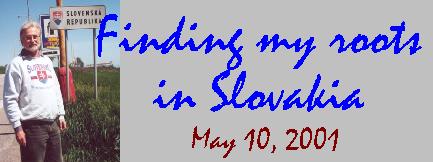|




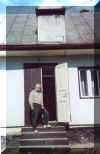


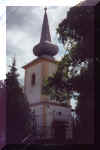










 



|
The
townspeople working the fields at the edge of Davidov stopped and gazed
curiously as our car pulled up next to the sign that marked the entrance
to the community. As I exited the car to pose by the sign for a
photograph, they couldn't help but wonder why someone would want to
record on film this tiny eastern Slovakian village located in the heart
of the Carpathian Mountains. My motive was purely personal and I knew
that Thursday, May 10, 2001 would be a day I would remember for the rest
of my life.
My grandfather, Jan Pacuta, left Davidov in 1900 to seek his fortune and
his future in America. He never returned to the village, but told his
family about the area that he called home. By the time I knew him, my
grandfather was a man in his 70s who, in his younger days, had run a
pool hall and Slovak store for the coal miners in Black Top, Ohio. He
and my grandmother, Julka Kolaschkovsky, had 11 children, four of them
dying in their youth. My father, John, was their fourth child named, as
is the Slovak custom, for a brother who had died shortly after birth. I
was born in Lore City, Ohio, about three miles from Black Top, and also
christened John, but have always been called Jack.
Armed with his birth certificate and military papers, I was determined
to fill in details about my grandfather's story and learn more about my
heritage. The opportunity came when my friend and
business colleague, Charles Leahy, and I conducted a series of seminars
in Romania. We agreed that Davidov was a mandatory stop on the way home
and made plans for this unforgettable experience.
After the breakup of the Austro-Hungarian Empire, Slovakia became part
of Czechoslovakia until 1993 when that nation amicably split into two
separate countries, identified by the two ethnic groups. Most people
know of Prague, the capital of the Czech Republic, but few know of
Bratislava and Kosice, the major cities of Slovakia. My quest took us to
Kosice, about 20 miles west of Davidov, where Charles and I hired a cab
driver, Milan Soffa, to serve as transportation and translator for the
day.
When my entry to Davidov was recorded on film, I asked Milan to talk
with a farmer in a nearby field to see if he knew of any Pacutas in the
village. The farmer grinned, and indicated that Yuri Pacuta and Jan
Pacuta, who has a wooden leg as a result of a World War injury, still
resided in Davidov. Milan obtained directions and we sought out Jan's
house. That's how I met Jan Pacuta, who smiled when I told him that we
had the same name. But this Jan Pacuta was not an immediate relative. He
and his wife, who couldn't stop giggling, directed us to Kamenna Poruba,
the neighboring village, where other Pacutas live.
Kamenna Poruba, about the same size as Davidov and two miles away, was
listed in my records as my grandfather's birthplace. As we entered the
village, Charles spotted a large wooden cross in the front of a house
across from the Greek Catholic church. He took a picture of it and I
noticed that the family name on the bottom of the cross was Bartko.
Bartkos had also lived in Lore City. The owner of the house, Anna
Rusnokova, greeted us and said that the Bartkos had been related to her
husband. (In Slovak, as in many Slavic languages, the surnames of women
end with "ova." For example, women of the Pacuta family would
be named "Pacutova.")
We were directed inside for cold cuts, coffee, and toasts from a bottle of
Scotch reserved for special occasions. Her house reminded me of those in
Black Top and Lore City. It was neat, clean, well maintained and
decorated with embroidered folk art and crystal. Wood furniture and
floors along with pristine lace curtains provided an elegance that was
deceptive from the outside. And always, in every room, were
representations of the Catholic religion that is such an essential part
of village life in Slovakia.
Anna said that Bartkos still lived in Kamenna Poruba, but she would take
us to the house of Anna Jackova, whose maiden name had been Pacutova. I
once again smiled because a Jacko family had also lived in Lore City. It
seemed that a mass migration had occurred to the same area in Guernsey
County, Ohio. Milan found the house and out came Anna, whose appearance
reminded me of my grandmother.
As we talked, the neighbor from across the street joined us and said
that her mother-in-law had been a Pacutova, and had had two brothers who
emigrated to the States. One of the brother's sons, Pavel, used to visit
Kamenna Poruba regularly until a few years ago. He was, she said, a
famous glass cutter in New York. When those words left her mouth, I fell
against the wall of the house. The person she had just described was my
father's first cousin, Paul, who had been an accomplished crystal cutter
until his death two years ago. Paul's clientele had included a long list
of celebrities, including Donald Trump.
When the neighbor identified herself as Helena Antusova, the pieces of
the puzzle began to fit. My Aunt Julie, who still lives in my
grandparents' house in Black Top, had given me a letter from Slovakia addressed to my
grandparents. It was from my grandfather's sister, Anna.
The name on the return address was "Jan Antus." Helena left us
to call Maria Lacnova, Paul's sister, who lives in Sacurov, another
nearby village, to let her know we were on our way. In the meantime, we
were treated to more food and toasts at the Jacko house, a Slovak
tradition of welcome that simply cannot be turned down.
Helena, now dressed in better clothes, joined us in the car and directed
us to Maria's house. When I saw Maria, I said to Charles, "She's a
Pachuta." For the next two hours, I talked, via Milan, with
my cousin Maria, who promptly notified her daughter and granddaughter
that I was in Sacurov. Out came more food and drink, accompanied by a
series of toasts. Maria showed me pictures of other family members and
filled in some of the information that had not made it to our side of
the Atlantic Ocean. She said, "Next time, let us know you're
coming." We all hugged and I left to continue my adventure.
While driving Helena home, she mentioned that her house was the house in
which my grandfather was raised. It had been built by my
great-grandfather in the 1860s. The original two rooms had since been
augmented by converting an attached stable into living space. After more
food and toasts, Charles photographed me in the doorway of the house, an
experience that is difficult to put into words.
But, one more stop remained. Helena accompanied us to the cemetery on a
hillside outside Kamenna Poruba and there she pointed out two simple
wooden crosses. On them were carved the names "Pavel Pacuta"
and "Anna Pacutova." "They are your
great-grandparents," she said. I knew what their names were, but
the graves suddenly made them real people. I stood and silently said hello to them. Many other graves had the names Pacuta
and Pacutova on them. My grandfather's two sisters and their husbands
were in the graveyard, and too many relatives to track in one day.
As we returned to Kosice, Milan said this was the most enjoyable
experience he'd ever had, and that if I knew of any other
Slovak-Americans who would like to find their relatives, he'd like to
help them. In the hotel that night, I stared out the window at the
rolling green hills of the Carpathians in front of me. My heritage now
looks different. In the mountains of eastern Slovakia, I could see
glimpses of all the influences that helped shape who I am. I smiled and
laughed to myself as tears filled my eyes. I had done it. In one day,
I'd had a lifetime of experiences.


|
|



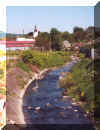


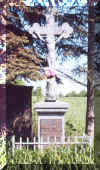


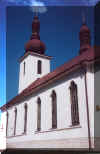













|

